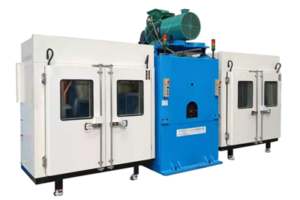Smithers adds tire dynamic ozone aging and cold temperature durability capabilities to Suzhou lab
Suzhou, China – Smithers announced the addition of ozone resistance and low temperature durability testing capabilities for tires. The new machine is installed at the Smithers Tire and Wheel Testing Laboratory in Suzhou, China, and will serve tire testing customers throughout the Asia Pacific region and around the world.
The tire is the only part of a vehicle that makes direct contact the driving surface. As a result, the tire is subject to a wide variety of environmental stressors, such as temperature swings, UV rays, and more. Tires are primarily comprised of rubber. The viscoelasticity of a rubber material changes significantly with fluctuations in temperature. Most rubber materials used in tires are unsaturated compounds, which are prone to chemical reactions when exposed to light, heat, oxides and other factors. This can lead to property changes and performance issues. Ozone can have a particularly powerful influence on rubber material properties and lifespan due to its strong oxidizing abilities.
The tire industry relies on laboratory testing to measure ozone resistance. Most of this testing focuses on rubber compounds, rather than whole tires. However, inadequate ozone resistance can be a symptom of sidewall cracking in consumer tires. In an effort to better test for this issue, the industry has been interested in options for ozone testing for whole tires. Another issue currently faced by the industry is a limited number of options for conducting whole tire low temperature endurance testing indoors. Most of this testing occurs outdoors.
“At Smithers, our top priority is to meet our clients’ needs and deliver accurate testing data, on time with excellent service,” said Henry He, general manager, Tire and Wheel Testing Center Asia Pacific, Smithers Materials Science and Engineering Division. “We invested in ozone resistance and low temperature durability testing to our tire laboratory in Suzhou to help our clients evaluate the durability performance of whole tires in a controlled, indoor environment. This will shorten the development cycle for our clients and lower their research and development costs.”
The new testing equipment can conduct ozone aging durability testing at an ozone concentration of up to 250 pphm and maintain temperatures as low as -40°C for low temperature durability testing. Under these conditions, expert test engineers can evaluate tire performance and durability at different speeds and air pressures and under different loads.
“Smithers is committed to fulfilling our promise of providing our clients with key testing capabilities to meet their changing R&D needs, said Derek Read, vice president, Asia Region, Global Development, Smithers Materials Science and Engineering Division. “We chose to add this specific capability to support industry development in Asia and help our clients continue to improve their products for the global marketplace.”

